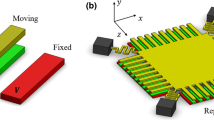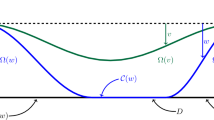Abstract
Perhaps the most ubiquitous phenomena associated with electrostatically actuated MEMS devices is the `pull-in' voltage instability. In this instability, when applied voltages are increased beyond a certain critical voltage there is no longer a steady-state configuration of the device where mechanical members remain separate. This instability severely restricts the range of stable operation of many devices. Here, a mathematical model of an idealized electrostatically actuated MEMS device is constructed for the purpose of analyzing various schemes proposed for the control of the pull-in instability. This embedding of a device into a control circuit gives rise to a nonlinear and nonlocal elliptic problem which is analyzed through a variety of asymptotic, analytical, and numerical techniques. The pull-in voltage instability is characterized in terms of the bifurcation diagram for the mathematical model. Variations in various capacitive control schemes are shown to give rise to variations in the bifurcation diagram and hence to effect the pull-in voltage and pull-in distance.
Similar content being viewed by others
References
W.S.N. Trimmer, Microrobots and micromechanical systems. Sens. Actuat. 19 (1989) 267–287.
H.C. Nathanson, W.E. Newell, R.A. Wickstrom and J.R. Davis, The resonant gate transistor. IEEE Trans. on Electron Devices 14 (1967) 117–133.
P.B. Chu and K.S.J. Pister, Analysis of closed-loop control of parallel-plate electrostatic microgrippers. Proc. IEEE Int. Conf. Robotics and Automation (1994) pp. 820–825.
J.I. Seeger and S.B. Crary, Stabilization of electrostatically actuated mechanical devices. Proceedings of the 1997 International Conference on Solid-State Sensors and Actuators (1997) pp. 1133–1136.
J.J. Seeger and S.B. Crary, Analysis and simulation of MOS capacitor feedback for stabilizing electrostatically actuated mechanical devices. Second Int. Conf. on the Simulation and Design of Microsystems and Microstructures – MICROSIM97 (1997) pp. 199–208.
E.K. Chan and R.W. Dutton, Effects of capacitors, resistors and residual change on the static and dynamic performance of electrostatically actuated devices. Proc. SPIE 3680 (1999) 120–130.
H.A.C. Tilmans and R. Legtenberg, Electrostatically driven vacuum-encapsulated polysilicon resonators. Part II. theory and performance. Sens. Actuat. A 45 (1994) 67–84.
C.H. Mastrangelo and C.H. Hsu, Mechanical stability and adhesion of microstructures under capillary forces – Part I: Basic theory. J. Microelectromech. Syst. 2 (1993) 33–--.
J.R. Gilbert, G.K. Ananthasuresh, and S.D. Senturia, 3D modeling of contact problems and hysteresis in coupled electro-mechanics. Proceedings of the 9th Annual International Workshop on Micro Electro Mechanical Systems (1996) pp. 127–132.
M.T.A. Saif, B.E. Alaca and H. Sehitoglu, Analytical modeling of electrostatic membrane actuator micro pumps. IEEE J. Microelectromech. Syst. 8 (1999) 335–344.
O. Francais and I. Dufour, Enhancement of elementary displaced volume with electrostatically actuated diaphragms: application to electrostatic micropumps J. Micromech. Microeng. 10 (2000) 282–286.
R. Apte, F. Sandejas, W. Banyai and D. Bloom, Grating light valves for high resolution displays. Solid State Sensors and Actuators Workshop June (1994) pp.---–---.
S. Timoshenko, Theory of Plates and Shells. New York: McGraw-Hill Book Company (1940) 492 pp.
A. Dec and K. Suyama, Micromachined varactor with wide tuning range. Electron. Lett. 33 (1997) 22–25.
O. Francais and I. Dufour, Dynamic simulation of an electrostatic micropump with pull-in and hysteresis phenomena. Sens. Actuat. A 70 (1998) 56–60.
N. Tas, J. Wissink, L. Sander, T. Lammerink and M. Elwenspoek, Modeling, design and testing of an electrostatic shuffle motor. Sens. Actuat. A 70 (1998) 171–178.
C. Hsu and W. Hsu, A two-way membrane-type micro-actuator with continuous deflections. J. Micromech. Microeng. 10 (2000) 387–394.
J.R. Gilbert and S.D. Senturia, Two-phase actuators: stable zipping devices without fabrication of curved structures. Solid-State Sensor and Actuator Workshop (1996) pp. 98–100.
D. Bernstein, P. Guidotti and J.A. Pelesko, Analytical and numerical analysis of electrostatically actuated mems devices. Proceeding of Modeling and Simulation of Microsystems 2000 (2000) pp. 489–492.
P. Penfield Jr. and R.P. Rafuse, Varactor Applications. Cambridge: MIT Press (1962) 623pp.
A.N. Semakhin and G.A. Shneerson, calculation of the leading corrections to the 'capacitor' capacitance between two conductors separated by a small gap. Sov. Phys. Tech. Phys. 35 (1990) 1115–1119.
M.R. Boyd, S.B. Crary and M.D. Giles, A heuristic approach to the electromechanical modeling of MEMS beams. Technical Digest Solid-State Sensor and Actuator Workshop (1994) pp. 123–126.
R.F. Harrington, Field Computation by Moment Methods. Piscataway, NJ: IEEE Press (1993) 229 pp.
A.A. Lacey, Thermal runaway in a non-local problem modelling ohmic heating: Part I: model derivation and some special cases. Eur. J. Appl. Math. 6 (1995) 127–144.
A.A. Lacey, thermal runaway in a non-local problem modelling ohmic heating: Part II: general proof of blow-up and asymptotics of runaway. Eur. J. Appl. Math. 6 (1995) 201–224.
J.A. Carrillo, On a nonlocal elliptic equation with decreasing nonlinearity arising in plasma physics and heat conduction. Nonlin. Anal. Meth. Applic. 32 (1998) 97–115.
I. Stakgold, Green's Functions and Boundary Value Problems. New York: Wiley (1998) 689 pp.
J. Bebernes and D. Eberly, Mathematical Problems from Combustion Theory. New York: Springer-Verlag (1989) 177 pp.
K. Toepfer, Grenzschichten in flussigkeiten mit kleiner reibung. Z. Math. Phys. 60 (1912) 397–398.
T.Y. Na, Computational Methods in Engineering Boundary Value Problems. New York: Academic Press (1979) 309 pp.
Author information
Authors and Affiliations
Rights and permissions
About this article
Cite this article
Pelesko, J., Triolo, A. Nonlocal problems in MEMS device control. Journal of Engineering Mathematics 41, 345–366 (2001). https://doi.org/10.1023/A:1012292311304
Issue Date:
DOI: https://doi.org/10.1023/A:1012292311304




